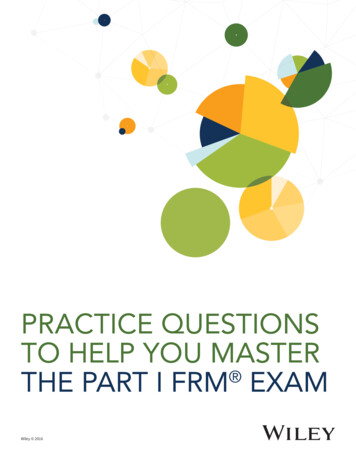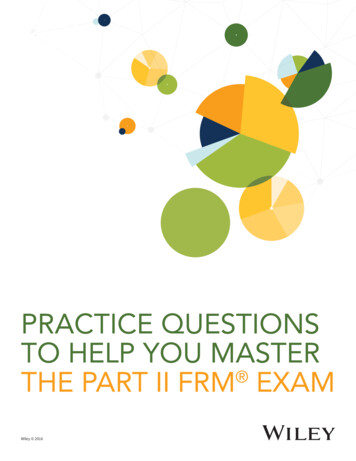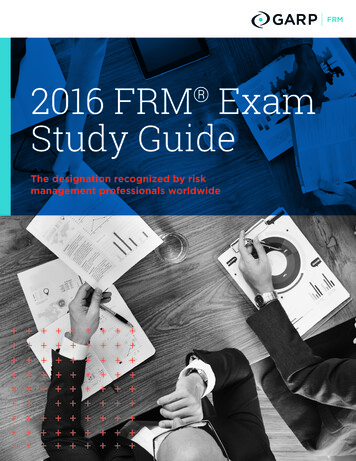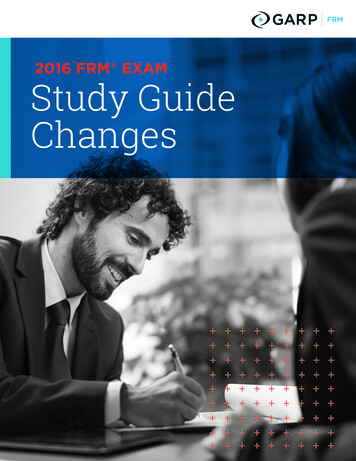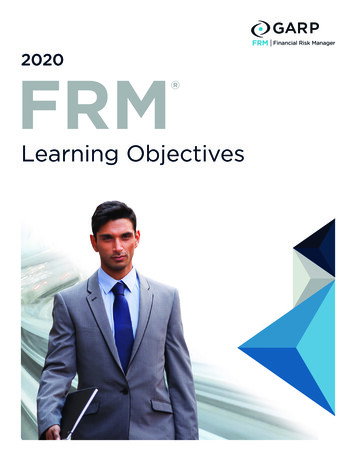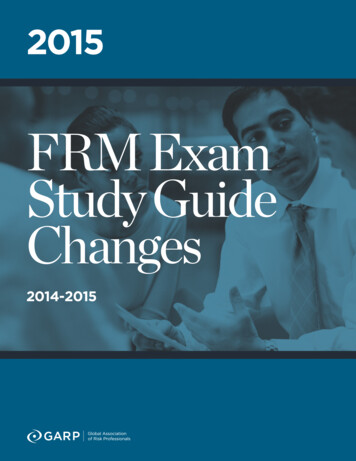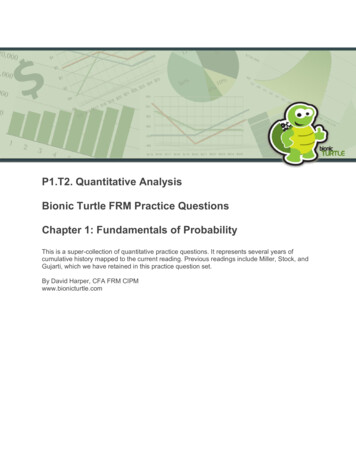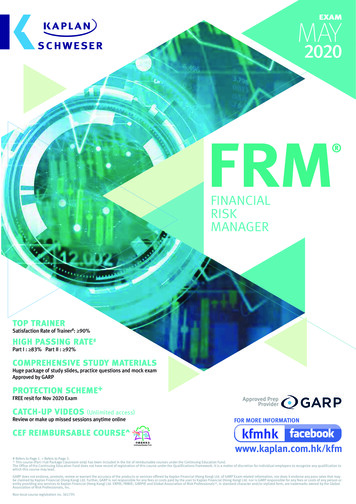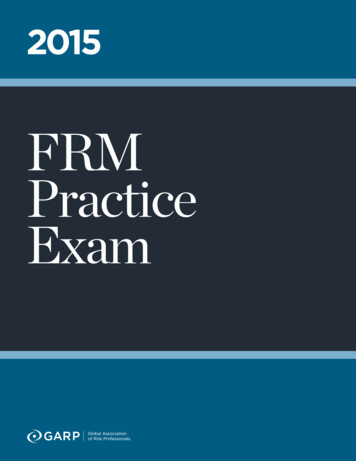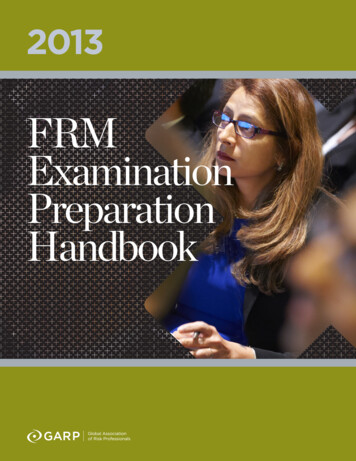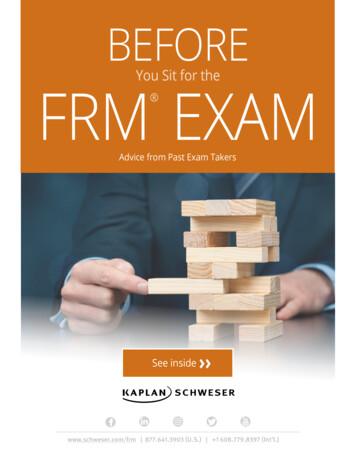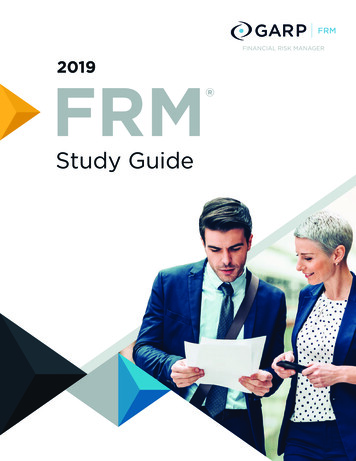
Transcription
FINANCIAL RISK MANAGER2019FRM Study Guide
2019 Financial Risk Manager (FRM ) Study GuideThe world’s mosthighly respecteddesignation forrisk managementprofessionalsgarp.org/frm1
2019 Financial Risk Manager (FRM )Exam Study GuideTOPIC OUTLINE, READINGS,TEST WEIGHTINGSREADINGSKey concepts appear as bullet points at thebeginning of each section and are intended to helpcandidates identify the major themes and knowledgeareas associated with that section.FRM EXAM PREP PROVIDERSThe Study Guide sets forth primary topics andsub-topics covered in the FRM Exam Part I and PartII. The topics were selected by the FRM Committeeas essential for today’s risk managers to master. Thetopics and their respective weightings are reviewedyearly to ensure the Exams are timely and relevant.The Study Guide also contains a full listing of all of thereadings that are recommended as preparation forthe FRM Exam Part I and Part II.FRM EXAM APPROACHThe FRM Exams are practice-oriented. Thequestions are derived from a combination of theory,as set forth in the readings, and “real-world” workexperience. Candidates are expected to understandrisk management concepts and approaches, as well asthe ways in which they would apply to a risk manager’sday-to-day activities. It is rare that a risk manager willbe faced with an issue that can immediately be slottedinto one category. In the real world, a risk managermust be able to identify any number of risk-relatedissues and be able to deal with them effectively.As such, the Exams are comprehensive in nature,testing a candidate on a number of risk managementconcepts and approaches.Questions for the FRM Exams are related to andsupported by the readings listed under each topicoutline. These readings were selected by the FRMCommittee to assist candidates in their review ofthe subjects covered by the Exams. It is stronglysuggested that candidates review these readingsin depth prior to sitting for each Exam. All of thereadings listed in the FRM Study Guide are availablethrough GARP. Further information can be foundon the GARP website.Some candidates may want to more formally reviewthe materials with FRM Exam Preparation Providers(EPPs). A list of EPPs that have registered with GARPcan be found on the GARP website. GARP does notendorse any EPP, but merely lists them as a service toFRM candidates.On the following pages, an asterisk after a reading indicates that the reading is freely available on the GARP website.
FRM EXAM PART IFOUNDATIONS OF RISK MANAGEMENTQUANTITATIVE ANALYSISFINANCIAL MARKETS AND PRODUCTSVALUATION AND RISK MODELSFRM EXAM PART IIMARKET RISK MEASUREMENT AND MANAGEMENTCREDIT RISK MEASUREMENT AND MANAGEMENTOPERATIONAL AND INTEGRATED RISK MANAGEMENTRISK MANAGEMENT AND INVESTMENT MANAGEMENTCURRENT ISSUES IN FINANCIAL MARKETS
FRM EXAM PART I2019 Financial Risk Manager (FRM ) Study GuideFoundations of Risk ManagementPART I EXAM WEIGHT 20%TOPICS AND READINGSThis area focuses on foundational concepts of risk management and how risk management can add value to anorganization. The broad knowledge points covered in Foundations of Risk Management include the following: Basic risk types, measurement and management toolsCreating value with risk managementThe role of risk management in corporate governanceEnterprise Risk Management (ERM)Financial disasters and risk management failuresThe Capital Asset Pricing Model (CAPM)Risk-adjusted performance measurementMultifactor modelsData aggregation and risk reportingEthics and the GARP Code of ConductTo cover these broad knowledge points, a set of curated readings is listed on the following page. Whiledetailed learning objectives associated with these readings are presented in the 2019 FRM Learning Objectivesdocument, a brief summary of how to relate these readings to the knowledge points follows.Reading 1 contains three chapters with the first two giving a broad overview of risk, different risk types, andhow risks can arise in an organization. The third chapter describes the role of corporate governance in riskmanagement including the role of the board of directors and other areas of an organization. The concept ofan organization’s risk appetite and how this is translated into a risk appetite framework and communicatedthroughout an organization is presented as well. Reading 2 introduces Enterprise Risk Management (ERM),a common and important method for assessing and managing risk in an organizational context. Reading 3focuses more specifically on risk taking by banks and how risk management can add or destroy value inthese institutions.As it is always important to learn from history, the next several readings (Readings 4, 5, and 6) describe variousfinancial disasters from the past with a particular focus on the recent global financial crisis. Reading 7 gives anuanced approach to interpreting financial failures and the role that risk management may, or may not, haveplayed in them.Reading 8 presents the Capital Asset Pricing Model (CAPM), one of the foundational developments in riskadjusted pricing and valuation. This is followed by a discussion, in Reading 9, of several commonly used CAPMrelated risk measures and their application to performance measurement. Reading 10 moves beyond CAPM andintroduces factor models and how they can be used to model returns.Data is the lifeblood of many large financial organizations and aggregating and reporting risk data has becomeincreasingly important. Reading 11 addresses this important topic. To help ensure ethical standards are upheldin the risk management profession, Reading 12 contains GARP’s Code of Conduct, a document that all FRMsare subject to.garp.org/frm4
FRM EXAM PART I2019 Financial Risk Manager (FRM ) Study GuideREADINGS FOR FOUNDATIONS OF RISK MANAGEMENT1.Michel Crouhy, Dan Galai, and Robert Mark, The Essentials of Risk Management, 2nd Edition(New York, NY: McGraw-Hill, 2014).2. Chapter 1. Risk Management: A Helicopter View (Including Appendix 1.1: Typology of Risk Exposures) Chapter 2. Corporate Risk Management: A Primer Chapter 4. Corporate Governance and Risk ManagementJames Lam, Enterprise Risk Management: From Incentives to Controls, 2nd Edition (Hoboken, NJ:John Wiley & Sons, 2014). 3.Chapter 4. What is ERM?René Stulz, “Risk Management, Governance, Culture and Risk Taking in Banks,” FRBNY Economic PolicyReview, (August 2016): 43-59.4.Steve Allen, Financial Risk Management: A Practitioner’s Guide to Managing Market and Credit Risk,2nd Edition (New York, NY: John Wiley & Sons, 2013). 5.Chapter 4. Financial DisastersMarkus K. Brunnermeier, “Deciphering the Liquidity and Credit Crunch 2007-2008,” Journal of EconomicPerspectives (2009): (23:1), 77-100.6.Gary Gorton and Andrew Metrick, “Getting Up to Speed on the Financial Crisis: A One-Weekend-Reader’sGuide,” Journal of Economic Literature (2012): 50(1), 128-150.7.René Stulz, “Risk Management Failures: What Are They and When Do They Happen?” Journal of AppliedCorporate Finance 20, No. 4 (2008): 39-48.8.Edwin J. Elton, Martin J. Gruber, Stephen J. Brown and William N. Goetzmann, Modern Portfolio Theoryand Investment Analysis, 9th Edition (Hoboken, NJ: John Wiley & Sons, 2014). 9.Chapter 13. The Standard Capital Asset Pricing ModelNoel Amenc and Veronique Le Sourd, Portfolio Theory and Performance Analysis (West Sussex, UK:John Wiley & Sons, 2003). Chapter 4. Applying the CAPM to Performance Measurement: Single-Index Performance MeasurementIndicators (Section 4.2 only)10. Zvi Bodie, Alex Kane, and Alan J. Marcus, Investments, 11th Edition (New York, NY: McGraw-Hill, 2017). Chapter 10. Arbitrage Pricing Theory and Multifactor Models of Risk and Return11. “Principles for Effective Data Aggregation and Risk Reporting,” (Basel Committee on BankingSupervision Publication, January 2013).12. GARP Code of Conduct.**This reading is freely available on the GARP website.garp.org/frm5
FRM EXAM PART I2019 Financial Risk Manager (FRM ) Study GuideQuantitative AnalysisPART I EXAM WEIGHT 20%TOPICS AND READINGSThis area tests a candidate’s knowledge of basic probability and statistics, regression and time series analysis,and various quantitative techniques useful in risk management. The broad knowledge points covered inQuantitative Analysis include the following: Discrete and continuous probability distributionsEstimating the parameters of distributionsPopulation and sample statisticsBayesian analysisStatistical inference and hypothesis testingEstimating correlation and volatility using EWMA and GARCH modelsVolatility term structuresCorrelations and copulasLinear regression with single and multiple regressorsTime series analysis and forecastingSimulation methodsTo cover these broad knowledge points, a set of curated readings is listed on the following page. Whiledetailed learning objectives associated with these readings are presented in the 2019 FRM Learning Objectivesdocument, a brief summary of how to relate these readings to the knowledge points follows.Reading 13 consists of five chapters. These chapters introduce basic, fundamental concepts related toprobability, statistics, probability distributions, Bayesian analysis, hypothesis testing, and confidence intervals.Regression analysis is an important statistical tool used to investigate relationships between variables. Thefirst three chapters in Reading 14 give a general introduction to regression analysis. These chapters cover bothsingle and multiple variable linear regression analysis. The fourth chapter presents methods for quantifying theestimation error associated with ordinary least squares regression and how to structure and evaluate tests ofstatistical hypotheses.Time series data occur frequently in finance. The four chapters in Reading 15 describe methods for analyzingtime series data in order to estimate statistics and extract other meaningful characteristics of the data. The firstchapter focuses on modeling and forecasting trends. The second chapter focuses on modeling and forecastingseasonality. The last two chapters focus on modeling cycles.The two chapters in Reading 16 introduce volatility, correlation and copulas and how to use the EWMA modeland the GARCH(1,1) model to estimate future covariance and volatilities.Simulation methods in finance are used to value and analyze complex financial instruments and portfolios.Reading 17 introduces simulation methods including Monte Carlo simulation and the use of the bootstrappingmethod. It also explains the advantages and disadvantages of the simulation approach to financial problemsolving and the techniques to reduce Monte Carlo sampling error.garp.org/frm6
FRM EXAM PART I2019 Financial Risk Manager (FRM ) Study GuideREADINGS FOR QUANTITATIVE ANALYSIS13. Michael Miller, Mathematics and Statistics for Financial Risk Management, 2nd Edition (Hoboken, NJ:John Wiley & Sons, 2013). Chapter 2. Probabilities Chapter 3. Basic Statistics Chapter 4. Distributions Chapter 6. Bayesian Analysis (pages 113-124 only) Chapter 7. Hypothesis Testing and Confidence Intervals14. James Stock and Mark Watson, Introduction to Econometrics, Brief Edition (Boston, MA: Pearson,2008). Chapter 4. Linear Regression with One Regressor Chapter 5. Regression with a Single Regressor Chapter 6. Linear Regression with Multiple Regressors Chapter 7. Hypothesis Tests and Confidence Intervals in Multiple Regression15. Francis X. Diebold, Elements of Forecasting, 4th Edition (Mason, OH: Cengage Learning, 2006). Chapter 5. Modeling and Forecasting Trend Chapter 6. Modeling and Forecasting Seasonality Chapter 7. Characterizing Cycles Chapter 8. Modeling Cycles: MA, AR, and ARMA Models16. John C. Hull, Risk Management and Financial Institutions, 5th Edition (Hoboken, NJ: John Wiley& Sons, 2018). Chapter 10. Volatility Chapter 11. Correlations and Copulas17. Chris Brooks, Introductory Econometrics for Finance, 3rd Edition (Cambridge, UK: Cambridge UniversityPress, 2014). Chapter 13. Simulation Methods (Note: EViews and other programming references are not required.)garp.org/frm7
FRM EXAM PART I2019 Financial Risk Manager (FRM ) Study GuideFinancial Markets and ProductsPART I EXAM WEIGHT 30%TOPICS AND READINGSThis area tests your knowledge of financial products and the markets in which they trade, more specifically,the following knowledge areas: Structures and functions of financial institutionsStructure and mechanics of OTC and exchange marketsStructure, mechanics, and valuation of forwards, futures, swaps, and optionsHedging with derivativesInterest rates and measures of interest rate sensitivityForeign exchange riskCorporate bondsMortgage-backed securitiesTo cover these broad knowledge points, a set of curated readings is listed beginning on the following page.While detailed learning objectives associated with these readings are presented in the 2019 FRM LearningObjectives document, a brief summary of how to relate these readings to the knowledge points follows.Reading 18 has three chapters. The first chapter describes the structure of commercial and investment banking,the way banks are regulated, the nature of risks facing them, and the role of capital in providing cushion againstlosses. The second chapter explains the risks and regulations faced by insurance companies, their capitalrequirements and performance ratios, and the types and key characteristics of pension funds. The third chapterintroduces mutual funds and hedge funds, examines their key differences, and describes various hedge fundstrategies and performance measures.Financial derivatives play a key role in risk management and their coverage is the basis of Reading 19, whichhas eleven chapters. Chapters 1 through 3 describe options, forwards, and futures and explain the mechanicsof futures markets and central counterparties, and the hedging strategies using futures. Chapters 4 through6 describe interest rates and interest rate sensitivity, the determination of forward and futures prices, andthe use of
2019 Financial Risk Manager (FRM ) Exam Study Guide TOPIC OUTLINE, READINGS, TEST WEIGHTINGS The Study Guide sets forth primary topics and sub-topics covered in the FRM Exam Part I and Part II. The topics were selected by the FRM Committee as essential for today’s risk managers to master. The topics and their respective weightings are reviewed
